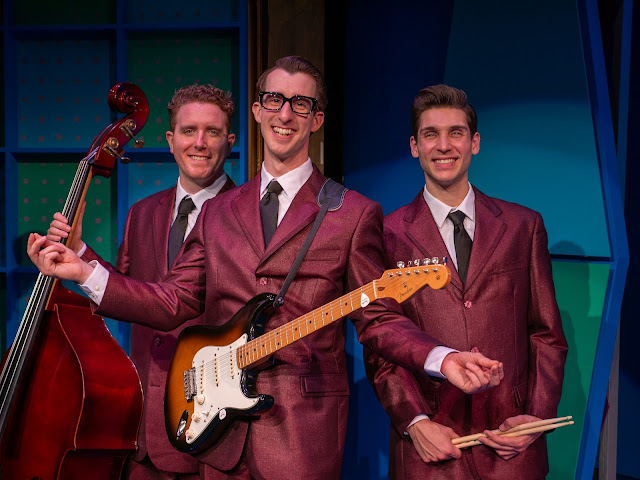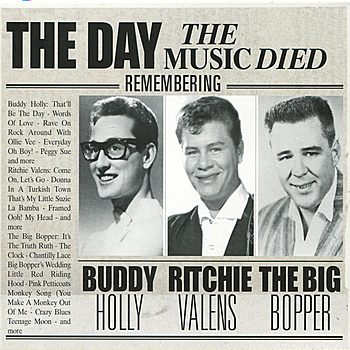Continuing a look at the events and people in Billy Joel’s We Didn’t Start the Fire.
Each two lines represent a year.
Little Rock, Pasternak, Mickey Mantle, Kerouac
Sputnik, Chou En-Lai, "Bridge on the River Kwai"
Lebanon, Charles de Gaulle, California baseball
Starkweather homicide, children of thalidomide
Buddy Holly, "Ben Hur", space monkey, Mafia
Hula hoops, Castro, Edsel is a no-go
U-2, Syngman Rhee, payola and Kennedy
Chubby Checker, "Psycho", Belgians in the Congo
1959:
Buddy Holly -
Charles Hardin Holley (1936 – 1959), known as Buddy Holly, was an American singer and songwriter who was a central and pioneering figure of mid-1950s rock and roll.
Buddy Holly and the Crickets in 1957 (top to bottom: Allison, Holly and Mauldin)
He was born to a musical family in Lubbock, Texas, during the Great Depression, and learned to play guitar and sing alongside his siblings. His style was influenced by gospel music, country music, and rhythm and blues acts, which he performed in Lubbock with his friends from high school.
He made his first appearance on local television in 1952, and the following year he formed the group "Buddy and Bob" with his friend Bob Montgomery. In 1955, after opening for Elvis Presley, he decided to pursue a career in music. He opened for Presley three times that year; his band's style shifted from country and western to entirely rock and roll. In October that year, when he opened for Bill Haley & His Comets, he was spotted by Nashville scout Eddie Crandall, who helped him get a contract with Decca Records.
Holly's recording sessions at Decca were produced by Owen Bradley, who had become famous for producing orchestrated country hits for stars like Patsy Cline. Unhappy with Bradley's musical style and control in the studio, Holly went to producer Norman Petty in Clovis, New Mexico, and recorded a demo of "That'll Be the Day", among other songs. Petty became the band's manager and sent the demo to Brunswick Records, which released it as a single credited to "The Crickets", which became the name of Holly's band. In September 1957, as the band toured, "That'll Be the Day" topped the US and UK singles charts. Its success was followed in October by another major hit, "Peggy Sue".
Holly made his second appearance on The Ed Sullivan Show in January 1958 and soon after toured Australia and then the UK.
Holly is often regarded as the artist who defined the traditional rock-and-roll lineup of two guitars, bass, and drums. He was a major influence on later popular music artists, including Bob Dylan, The Beatles, The Rolling Stones, Eric Clapton, The Hollies, Elvis Costello, Dave Edmunds, Marshall Crenshaw, and Elton John.
He was among the first artists inducted into the Rock and Roll Hall of Fame, in 1986.
Relevance to 1959:
In early 1959, Holly had assembled a new band, consisting of future country music star Waylon Jennings (bass), famed session musician Tommy Allsup (guitar), and Carl Bunch (drums), and embarked on a tour, the Winter Dance Party tour, of the midwestern US.
After a show in Clear Lake, Iowa, Holly chartered a plane to travel to his next show in Moorhead, Minnesota. Soon after takeoff, the plane crashed, killing Holly, Ritchie Valens, The Big Bopper, and pilot Roger Peterson in a tragedy later referred to by Don McLean as "The Day the Music Died" in his song "American Pie".
The Winter Dance Party tour began in Milwaukee, Wisconsin, on January 23, 1959. The amount of travel involved created logistical problems, as the distance between venues had not been considered when scheduling performances. Adding to the problem, the unheated tour buses twice broke down in freezing weather, with dire consequences. Holly's drummer Carl Bunch was hospitalized for frostbite to his toes (sustained while aboard the bus), so Holly decided to seek other transportation.
On February 2, before their appearance in Clear Lake, Iowa, Holly chartered a four-seat Beechcraft Bonanza airplane for Jennings, Allsup, and himself, from Dwyer Flying Service in Mason City, Iowa. Holly's idea was to depart following the show at the Surf Ballroom in Clear Lake and fly to their next venue, in Moorhead, Minnesota, via Fargo, North Dakota, allowing them time to rest and launder their clothes and avoid a rigorous bus journey.
Immediately after the Clear Lake show (which ended just before midnight), Allsup agreed to flip a coin for the seat with Valens. Valens called heads; when he won, he reportedly said, "That's the first time I've ever won anything in my life." Allsup later opened a restaurant/bar in Fort Worth, Texas, called Heads Up Saloon. Waylon Jennings voluntarily gave up his seat to J. P. Richardson (the Big Bopper), who had influenza and complained that the tour bus was too cold and uncomfortable for a man of his size.
The pilot, Roger Peterson, took off in inclement weather, even though he was not certified to fly by instruments only. Buddy's brother Larry Holley said:
"I got the full report from the Civil Aeronautics – it took me a year to get it, but I got it – and they had installed a new Sperry gyroscope in the airplane. The Sperry works different than any other gyro. One of them, the background moves and the plane stays like this [stationary], and in the other one the background stays steady and the plane moves, it works just backwards. He [the pilot] could have been reading this backwards... they were going down, they thought they were still climbing."
Shortly after 12:55 am on February 3, 1959, Holly, Valens, Richardson, and Peterson were killed when the aircraft crashed into a cornfield five miles northwest of Mason City shortly after takeoff. The three musicians, who were ejected from the fuselage upon impact, sustained severe head and chest injuries. Holly was 22 years old.
The report did not mention a gun belonging to Holly that was found by a farmer two months after the crash. Newspaper accounts of the gun discovery fuelled rumours among fans that the pilot was somehow shot, causing the crash. Another curious finding at the crash was that Richardson's body was discovered nearly 40 feet (12 meters) away from the crash while the others were found in or near the wreckage. However, an autopsy done at the request of Richardson's son in 2007 found no evidence to support the rumours. Dr. Bill Bass, a forensic anthropologist at the University of Tennessee, stated that "There was no indication of foul play," and that Richardson "died immediately."
Signpost near the Clear Lake crash site
Holly's headstone in the City of Lubbock Cemetery
Holly's body was interred in the City of Lubbock Cemetery, in the eastern part of the city. His headstone carries the correct spelling of his surname (Holley) and a carving of his Fender Stratocaster guitar.
Giant glasses mark the entrance to the Buddy Holly Centre in Lubbock, Texas.
By the way:
- Holley was known as Buddy Holly from an incorrect name in a contract.
- The belief that the plane which crashed was called “American Pie” is a myth.
- Though several Buddy Holly songs were hits, only “That’ll Be the Day” was a #1 hit on the Billboard Hot 100.
- If not for Buddy Holly's band, The Crickets, there would be no Beatles. John, Paul, George, and Stu Sutcliffe (who played bass for the band during the Hamburg days) were all huge Buddy Holly fans. When trying to come up with a new name for their band (The Quarrymen, their original name after the school they went to, was growing long in the tooth), they thought of the Crickets. Then insects. Then beetles. Then eventually, after several variations, as a pun … Beatles. "It was beat and beetles, and when you said it people thought of crawly things, and when you read it, it was beat music,” John Lennon explained in 1964.
- According to The Buddy Holly Story (1979) by John Goldrosen, Elton John started wearing horn-rimmed glasses at age 13 because of Buddy Holly — even though young Elton didn’t even need glasses.
- Buddy Holly played Duluth, Minnesota at the Duluth National Guard Armory on January 31, 1959 — the next-to-last show he would play — and young 17-year-old Robert Zimmerman was supposedly 3 feet away from him. Bob Dylan mentioned this story in his acceptance speech when Time Out of Mind won the Grammy Award for Album of the Year in 1998.
- When the plane crashed on January 31, 1959, his signature glasses were not immediately found. Some of the belongings from the wreckage weren’t discovered until after the snow melted in the spring. The glasses were given to the sheriff’s office and placed into an envelope, but that envelope was misplaced when the Cerro Gordo County offices moved to a different courthouse. They weren’t re-discovered until a sheriff found the long-lost envelope in a courthouse storage unit in March, 1980. They were eventually passed along to Buddy Holly’s widow María Elena Santiago, who manages his estate.
- “Peggy Sue" was originally "Cindy Lou." The single, released on September 20, 1957, first carried the moniker of Holly’s niece, Cindy Lou Kaiter. But Jerry Allison, The Crickets’ drummer who co-wrote the song (with Holly and Norman Petty), prevailed upon the others to name it after his girlfriend, Peggy Sue Gerron. Happy ending: Allison and Peggy Sue got married. Unhappy: they divorced in 1965.
- In June 1956, Holly along with his older brother Larry as well as Allison and Sonny Curtis went to see the film The Searchers, starring John Wayne, in which Wayne repeatedly used the phrase "that'll be the day". This line of dialogue inspired the young musicians to write the song by that name.
- On 1st July 1976, Paul McCartney purchased the rights to Buddy Holly’s entire song catalogue.
- Holly wed María Elena Holly (née Santiago), who Buddy two weeks after meeting her at a music publisher in New York, where she worked. She was pregnant when he died, but suffered a miscarriage a few days later. Santiago-Holly still controls much of the continuing business related to Holly’s music, but doesn’t own the songs—they’re held by Paul McCartney. In 2009, Santiago-Holly told MassLive.com that she liked “American Pie” but disagreed with its central premise. "Buddy may not be here, but the music has not died," she said. "It is still alive and well."
Buddy Holly & The Crickets 1958 Australian Tour Program w/Jerry Lee Lewis, Paul Anka and others












No comments:
Post a Comment
Note: Only a member of this blog may post a comment.